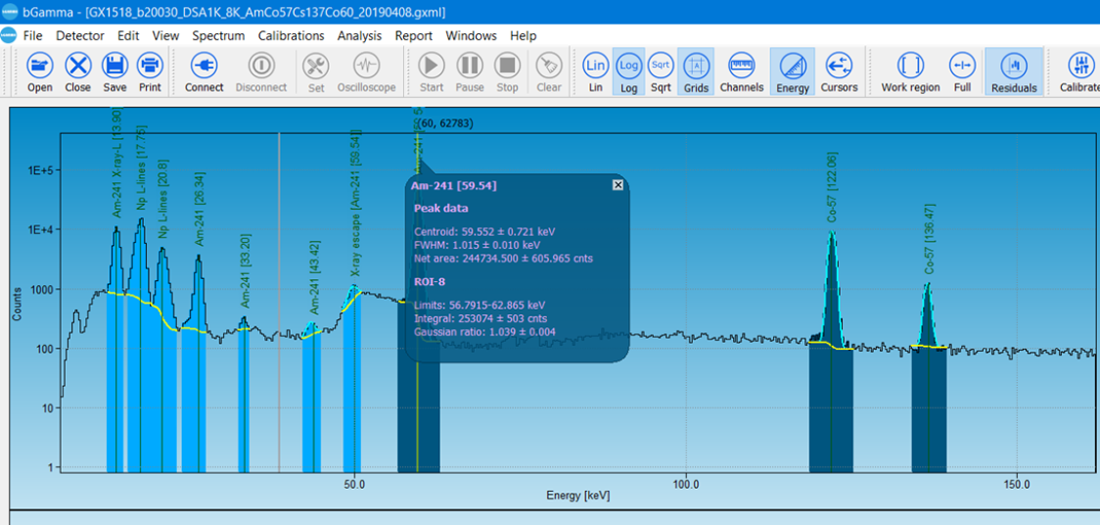This year’s SRP AGM is being held in Bournemouth and JCS
We will be showcasing our range of instruments, shielding, detectors and exhibiting our RMS30 gamma and neutron sensors which, as a smart device, is gaining some serious traction across the UK nuclear landscape.
This year we’ll also be demonstrating the BrightSpec MCA range, their new dedicated SiPM MCA and their bGamma, gamma spectroscopy software.
Visit us on Stand 27 to see a demo and bring along any questions.

We will also be exhibiting:
- Networked Radiation Monitoring Systems
- Gamma Dose-rate Monitors
- Installed Radiation Monitors
- Handheld Radiation Monitors
- Equipment Obsolescence & EOL Management
- Radiation Shielding Materials, Standard & Exotic
Date: 5 – 8 July 2021
Location: Bournemouth International Centre

Announcing the new Brightspec Topaz-SiPM, a miniature MCA designed specifically for SiPM detectors
TOPAZ-SiPM is a compact, stand-alone digital Multi-Channel Analyser (MCA), that is able to perform Pulse Height Analysis (PHA) of the signal produced by scintillation detectors which incorporates Si devices as photomultipliers (SiPMs). These type of scintillators can use standard crystals such as NaI(Tl), CsI(Tl), BGO, LaBr3 (Ce), LaCl3(Ce), etc.
With a size of only 7 x 4.5 x 2.6cm, the Topaz-SiPM is the smallest of the Topaz MCA series and very likely the smallest fully-featured MCA on the market today.
Main features:
- Two modes of acquisition: Pulse Height Analysis (PHA) and Multi-Channel Scaling (MCS)
- Up to 4096 channels
- Analogue amplification factor from 1 to 16
- Digital pulse processing using the traditional trapezoidal shaper
- Built-in digital Baseline Restorer (BLR) and Pile-Up Rejector (PUR)
- Advanced baseline noise reduction techniques to improve performance with noisy SiPMs
- 5V low-ripple, low-noise supply for the SiPM preamplifier
- Additional programmable External I/O can be used as an external counter input or SCA output
- USB 2.0 communications interface
- Powered from the PC via the USB cable
- Size: 70 x 45 x 26mm, PCB alone is 63 x 39mm
The PCB board alone is available separately to OEM customers.
UK National Conference on Applied Radiation Metrology – CARM 2018
JCS are very happy to be exhibiting at CARM, NPL next week.
We will be showcasing our measurement capabilities and shielding materials along with the RMS30 Intelligent Monitor platform and its gamma and neutron sensors; which are now being used to great effect across the UK nuclear landscape.
The UK National Conference on Applied Radiation Metrology (CARM 2018) is the latest in a series of annual three-day conferences run by NPL for the radiation metrology community, bringing together expertise from areas as diverse as the nuclear industry, detector manufacturers, radioanalytical laboratories and academia.
The scope will include recent advances in the underlying science (such as the application of fast neutrons and radionuclide production), as well as the practical application of radiation detectors and techniques.
Please note that CARM 2018 incorporates meetings of the IRMF and ARMUG. It is a great opportunity to keep up-to-date on progress in the radiation metrology sphere and to network with colleagues across a wide range of sectors.
6 – 8 Nov 2018
JCS team up with Omniflex to make our monitors compatible with the Omniflex Radiological Protection Gateway (RPN1) System.
The Omniflex Radiological Protection Gateway (RPN1) is an innovative product, based on well-proven technology that simplifies the process of gathering data from radiation detection devices such as the JCS range of Gamma Probes and Neutron Sensors.
By combining all of the required features in a standard COTS (Commercially Off-The-Shelf) product, the Teleterm RPN1 provides trouble-free installation and set-up.
Within a matter of minutes, the data from your JCS radiation detection devices can be readable on your Radiological Surveillance SCADA System.

The Teleterm RPN1 gateways simply connect together on an intelligently designed Redundant Fibre+Power ring network, using ‘Link In’ and ‘Link Out’ connectors on the top of the units (cables are supplied in standard lengths), providing quick and easy installation with minimum disturbance to other RPN1 gateways on the network. RPN1 can be connected to any range of JCS Gamma Probes and Neutron Sensors via RS485, completely simplifying the process of radiation monitoring.
Benefits of this System:
- Substantiated by the Nuclear Industry
- Proven significant cost savings on conventional radiological monitoring systems
- No on-site terminations required, increasing reliability and saving thousands of man hours terminating cables.
- Plug and Play design reduces operational and maintenance costs.
- Enables data to be easily connected to SCADA/HMI via RS485.
- Connects on a combined AC Power and Ethernet Fibre Optic ring network
- Redundant network with self-healing Ethernet ring topology.
- Future proof design allows compatibility with new and existing JCS radiation detection devices
Wireless Networking

The Omniflex Teleterm ISA100 Wireless Interface Node (W3) is an innovative product, based on well-proven technology that simplifies the process of gathering data from radiation detection devices such as the John Caunt Scientific range of Gamma Probes and Neutron Sensors.
By combining all of the required features in a standard COTS (Commercially Off-The-Shelf) product, the Teleterm W3 provides trouble-free installation and set-up. Within a matter of minutes, the data from your radiation detection devices can be readable on your Radiological Surveillance SCADA System.
Benefits of the Teleterm W3 System:
- Substantiated by the Nuclear Industry
- Proven significant cost savings on conventional radiological monitoring systems
- No on-site terminations required, increasing reliability and saving thousands of man hours terminating cables.
- Plug and Play design reduces operational and maintenance costs.
- Enables data to be easily connected to SCADA/HMI via secure ISA100wireless network.
- Self-healing wireless mesh network.
- Suitable for mobile radiation monitoring applications where cabling is not possible.
- Future proof design allows compatibility with new and existing JCS radiation detection devices.
Radiation Sensing & Measurement, A Special Scintillation Detectors Event
JCS Nuclear Solutions is delighted to host a special scintillation detectors workshop with our partner Scionix. Dr Paul Schotanus has been designing and manufacturing specialist scintillation detectors for 40+ years and his company, Scionix, is at the forefront of novel radiation detector design and development.
This workshop will cover:
- Principals of radiation detection with scintillators
- Scintillation detector design and optimisation
- New and emerging scintillator technologies
- Advances in detector readout technologies
- Working case studies of scintillators in the nuclear sector
- An opportunity to discuss your challenges and queries
Spaces are free but limited, please click here to register and be sure to book early.
Mon 5 February 2018
13:00 – 15:00
Birchwood Park
Risley
Warrington
WA3 6YN
Oliver Caunt, MD of JCS, has been a contributing partner in the European consortium Fincoda, established to develop a toolkit to measure innovative capacity.
Fincoda is an online psychometric survey that has been designed for students, graduates, employees and employers to use as a tool for identifying, measuring and demonstrating innovative capacity in people. This is also an incredibly powerful tool for recruitment and development within organisations.
Contributing to the development of this toolkit has been a rewarding experience. At JCS, Innovation is at the core of our operating culture, not only in the products and services that we supply, but also in how we operate as a business and collaborate with our partners and customers.
For JCS, 2015 marked 40 years of developing and supplying nuclear radiation sensing and shielding solutions in a wide variety of sectors. We have remained at the forefront of our industry, as a vibrant and independent family business, by adopting innovative working practices. These give us the agility we need, as an SME, to take on the interesting and unusual projects, which in turn, as with Fincoda, feed back into our product design and evolution as a company.
We are our proud of our approach to a partner-driven business model, where we identify symbiotic strengths in key partners to combine with our skill set and solve complex measurement and shielding solutions.
This approach allows us to remain a lean yet combine with our partners to supplement our core skills in whichever direction a project needs. Being a lean and agile team, is key to our success and underpins our ability to adapt to the ever-changing and always-challenging sectors that we serve.
Operating this model has helped JCS establish as a strategic integrator for complex solutions in defence, nuclear, medical, research and industrial applications.
Recently, JCS was nominated alongside the University of Liverpool, as the lead-partner in an Innovate UK grant funded project to develop a highly technical instrument designed to measure the fissile content of live reactor cores, from a distance.
Our reactor monitor, housed in a shipping container and located up to 80m from the reactor itself, will give operators and regulators real-time and accurate measurements of the fuel and related processes. This is a first of class development, combines existing technology used in particle physics experiments with cutting edge detector technologies allowing us to measure and process the data from anti-neutrinos, and thousands of related detector signals. Project Vidarr is full-steam ahead and has considerable promise.
We are proud to be solving complex POCO (post operative clean out) and decommissioning challenges at Sellafield and beyond with innovative yet simple technology, providing inspectors with accurate gamma measurements in hard-to-reach and highly radioactive locations.
Innovation permeates through our entire operating culture, is fundamental to our approach in all operations and underpins how we, as a team, approach any challenge.
The Fincoda project will be coming to end in December 2017 and its success will be marked as we launch the tool to the world.
Read more about the Fincoda assessment tool here
Read more about reactor monitoring with project Vidarr here
Learn about JCS Sensing and Shielding solutions here


